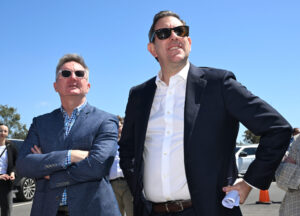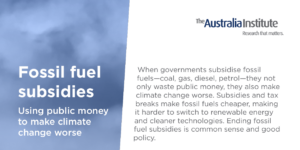by Richard Denniss
[Originally published by the Guardian Australia, 03 September 2020]
Rather than drill new fracking wells into prime farmland, the quickest, cleanest and most economically efficient way to boost the supply of gas in Australia is to stop wasting it.
According to the Australian Industry (AI) Group’s budget submission, “Ramping up support for manufacturers to transition from gas to electricity – from gas boilers to heat pumps – would both cut costs and allow them to lower emissions with onsite or offsite renewables.” I couldn’t agree more. And there is literally no better time for the federal government to support private investment than in the middle of a recession in which many factories, and many suppliers, have spare capacity.
It is not just manufacturers that don’t really need to burn gas; the Australian electricity industry is trying to wean itself off the stuff too.
Before Australia started exporting gas in huge quantities, burning gas was a relatively cheap way to produce electricity during peak times. But that’s no longer the case. According to the Australian Energy Market Operator (Aemo) the amount of gas Australia burned for electricity is expected to decline by two-thirds in the next eight years. Needless to say, the faster we can shut down gas-fired electricity generators, the less need we will have to frack more gas. Rapidly phasing out our gas-fired generators will free up gas for the manufacturers who are slow to electrify, and free up gas to export.
And then there’s households. An enormous amount of energy is wasted in Australia by heating water to the wrong temperature. Australian houses are designed to waste enormous amounts of gas and electricity making water just hot enough to burn us so that we can then mix it with cold water to have a nice warm shower. It’s ludicrous, but then again, so is fracking farmland, subsidising coal-fired power stations and claiming that electric cars will “end the weekend”.
If the Morrison government was at all interested in helping manufacturers and households lower their energy bills, they would be offering financial support to companies and households that would make long-run savings in their energy bills from short-term investments in new technology.
While AI Group wants “$500m over two years for capital grants to rapidly scale up the penetration of existing technologies that are uncommon in the Australian market”, the government seems determined to offer subsidies for the gas industry to build enormous pipelines to customers who are trying to switch away from gas.
The government prefers not to call its support for the fossil fuel industry a “subsidy”. Instead it talks about the economic benefits of providing support to gas producers in the form of off-take agreements, safe in the knowledge that no one knows what the hell an “off-take agreement” is.
According to capitalism, when an investor builds a new hotel, a new car factory or a new restaurant, they are taking an enormous risk that people will want to pay for their rooms, their cars or their meals. In return for taking this risk, investors expect to make a profit by selling the products for more than they cost to make.
But, according to a leaked interim report from the manufacturing taskforce of the national Covid commission, led by gas industry-linked Nev Power, the best way to get the gas industry to invest in new gas wells is to promise to buy enormous amounts of gas at an agreed price for the next 20 or 30 years. You can see why the gas industry is so excited about a “gas-led recovery” – the government has essentially guaranteed both the volume and price of the gas they sell for decades to come.
And it gets even better. When the market price for gas becomes lower than the agreed price, the government still has to buy it from the gas companies for the fixed price and then try and on-sell it for whatever they can. But if the market price is higher than the price the government promised to buy the gas for, then the gas companies can sell at a higher price than agreed and make an even bigger profit.
Sadly, this isn’t a new idea. The Northern Territory government committed to buy more than $4bn worth of gas from the Italian company Eni back in 2009 on the basis that they would be able to on-sell the gas and, among other things, promote manufacturing. More than a decade later, the Eni Blacktip entity has paid no royalties or company tax on this deal. And despite the NT government spending billions of dollars, employment in relevant manufacturing sectors has actually declined.
Of course, it’s not just the NT government that has spent enormous amounts on gas at inflated prices to “stimulate investment”. In the words of the Western Australia Department of Treasury: “The cost of Western Australia’s assistance to the North West Shelf project (eg payment of subsidies to the state’s power utility to help cover the losses it initially incurred under crucial ‘take or pay’ gas contracts) is estimated to be around $8bn.”
Ouch.
Conservatives love to rage against the modest subsidies provided to renewable energy in Australia while turning a blind eye to the enormous infrastructure subsidies, tax concessions and “off-take agreements” provided to the fossil fuel industry. But, according to the peak body of the biggest manufacturers, the best thing the Morrison government could do to help manufacturing would be to subsidise the upfront costs of electrification.
Not even big business wants a “gas-led recovery”. On the contrary, they want the government to help lead manufacturing away from gas and towards the lower cost and lower emissions associated with electrification. But in the Australian energy policy culture war, the most likely outcome is that the government will ignore the big energy users – in much the same way they ignore the world’s economists and scientists. Think about that the next time you are cooling down your hot water.
• Richard Denniss is the chief economist at independent thinktank The Australia Institute
Between the Lines Newsletter
The biggest stories and the best analysis from the team at the Australia Institute, delivered to your inbox every fortnight.
You might also like
The great gas rip off: how the government can stop us all getting burned
The Albanese government could soon intervene to start fixing one of the biggest ongoing public policy fiascos in this country’s history: Australia’s rampant, uncontrolled gas export industry.
Fossil fuel subsidies
When governments subsidise fossil fuels—coal, gas, diesel, petrol—they not only waste public money, they also make climate change worse. Subsidies and tax breaks make fossil fuels cheaper, making it harder to switch to renewable energy and cleaner technologies. Ending fossil fuel subsidies is common sense and good policy.
Why a fossil fuel-free COP could put Australia’s bid over the edge
When the medical world hosts a conference on quitting smoking, they don’t invite Phillip Morris, or British American Tobacco along to help “be part of the solution”.



